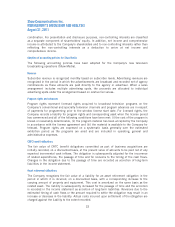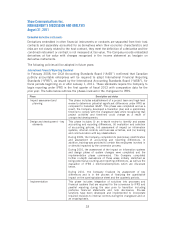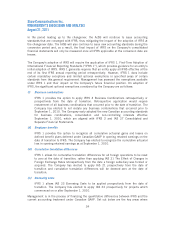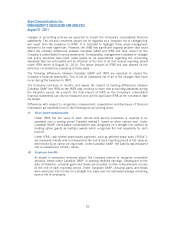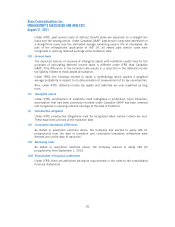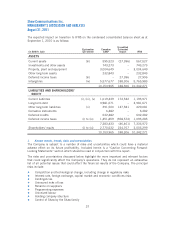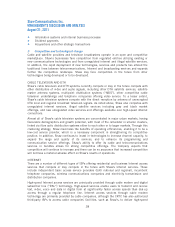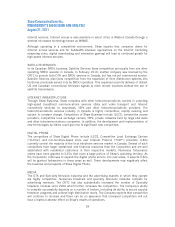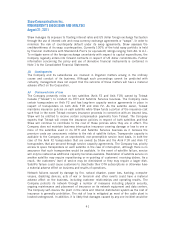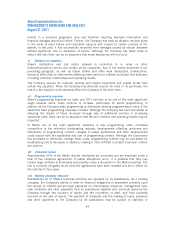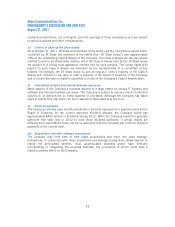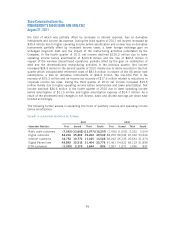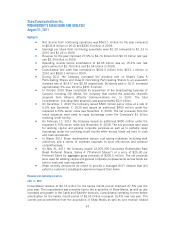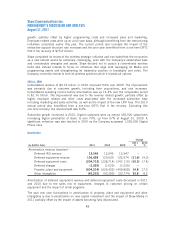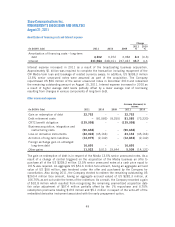Shaw 2011 Annual Report Download - page 45
Download and view the complete annual report
Please find page 45 of the 2011 Shaw annual report below. You can navigate through the pages in the report by either clicking on the pages listed below, or by using the keyword search tool below to find specific information within the annual report.Shaw Communications Inc.
MANAGEMENT’S DISCUSSION AND ANALYSIS
August 31, 2011
Shaw manages its exposure to floating interest rates and US dollar foreign exchange fluctuation
through the use of interest rate and cross-currency exchange agreements or “swaps”. In order to
minimize the risk of counterparty default under its swap agreements, Shaw assesses the
creditworthiness of its swap counterparties. Currently 100% of the total swap portfolio is held
by financial institutions with Standard & Poor’s (or equivalent) ratings ranging from AA- to A-1.
To mitigate some of the foreign exchange uncertainty with respect to capital expenditures, the
Company regularly enters into forward contracts in respect of US dollar commitments. Further
information concerning the policy and use of derivative financial instruments is contained in
Note 1 to the Consolidated Financial Statements.
iii) Contingencies
The Company and its subsidiaries are involved in litigation matters arising in the ordinary
course and conduct of its business. Although such proceedings cannot be predicted with
certainty, management does not expect that the outcome of these matters will have a material
adverse effect on the Corporation.
iv) Uninsured risks of loss
The Company presently relies on two satellites (Anik F2 and Anik F1R) owned by Telesat
Canada (“Telesat”) to conduct its DTH and Satellite Services business. The Company owns
certain transponders on Anik F2 and has long-term capacity service agreements in place in
respect of transponders on both Anik F1R and Anik F2. As the satellite owner, Telesat
maintains insurance policies on each satellite while Shaw funds a portion of the insurance cost
such that in the event Telesat recovers insurance proceeds in connection with an insured loss,
Shaw will be entitled to receive certain compensation payments from Telesat. The Company
expects that Telesat will renew the insurance policies in respect of both satellites and that
Shaw will continue to contribute to the cost of these policies while they are in effect. The
Company does not maintain business interruption insurance covering damage or loss to one or
more of the satellites used in its DTH and Satellite Services business as it believes the
premium costs are uneconomic relative to the risk of satellite failure. Transponder capacity is
available to the Company on an unprotected, non-preemptible service level basis, in both the
case of the Anik F2 transponders that are owned by Shaw and the Anik F1R and Anik F2
transponders that are secured through service capacity agreements. The Company has priority
access to spare transponders on each satellite in the case of interruption, although there is no
assurance that such transponders would be available. In the event of satellite failure, service
will only be restored as additional capacity becomes available. Restoration of satellite service on
another satellite may require repositioning or re-pointing of customers’ receiving dishes. As a
result, the customers’ level of service may be diminished or they may require a larger dish.
Satellite failure could cause customers to deactivate their DTH subscriptions or otherwise have
a material adverse effect on business and results of operations.
Network failures caused by damage by fire, natural disaster, power loss, hacking, computer
viruses, disabling devices, acts of war or terrorism and other events could have a material
adverse affect on the business, including customer relationships and operating results. The
Company protects its network through a number of measures including physical security,
ongoing maintenance and placement of insurance on its network equipment and data centers.
The Company self-insures the plant in the cable and Internet distribution system as the cost of
insurance is generally prohibitive. The risk of loss is mitigated as most of the cable plant is
located underground. In addition, it is likely that damages caused by any one incident would be
41



